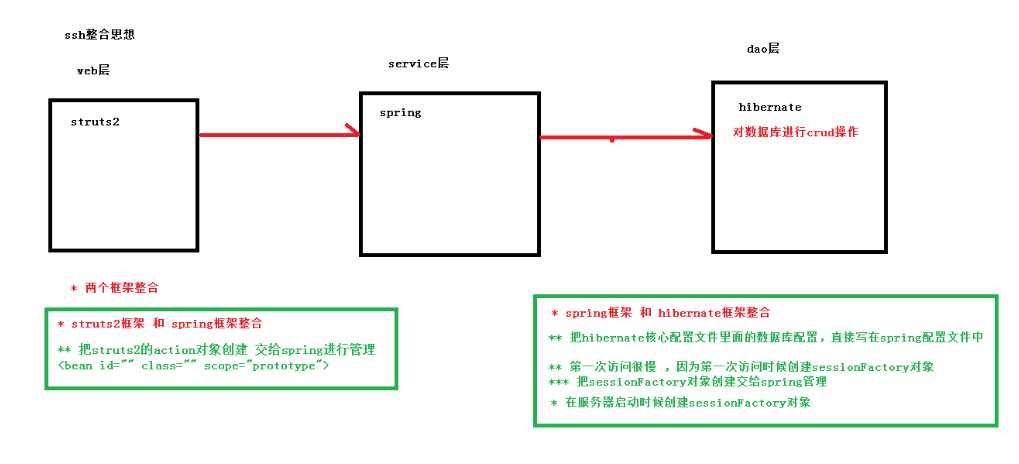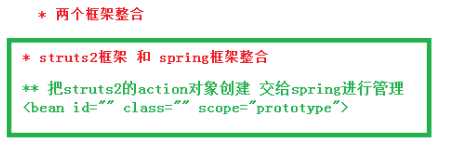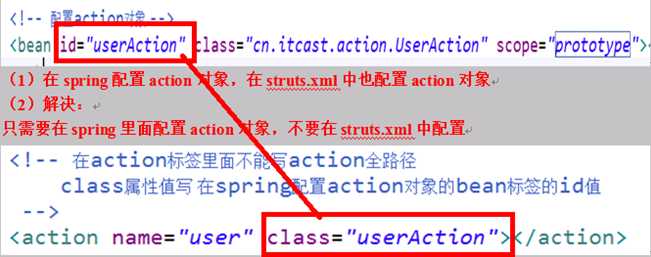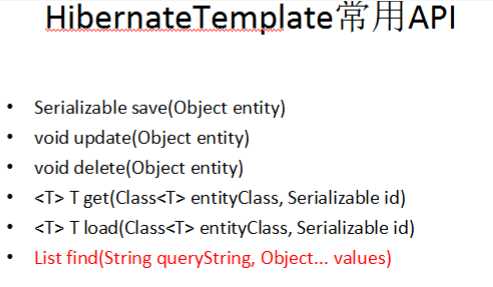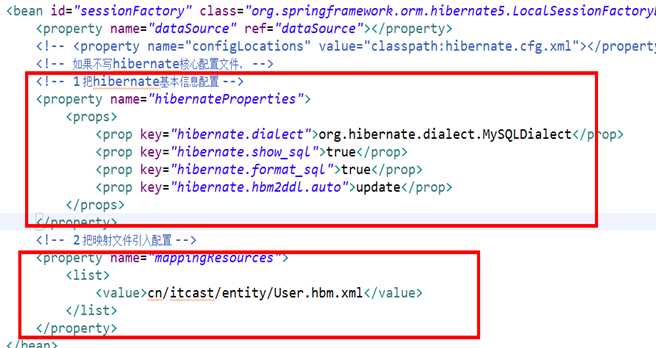SSH三大框架整合
(1)struts2
(2)hibernate5.x
(3)spring4.x
回顾SSH框架知识点
Hibernate框架
1、 hibernate核心配置文件
(1)orm思想
– 对象关系映射
(1)数据库信息
(2)hibernate信息
(3)映射配置
(4)hibernate核心配置文件
– 如果单纯使用hibernate框架,核心配置文件名称 hibernate.cfg.xml和位置 src下面 固定的
-hibernate和spring整合时候,hibernate核心配置文件名称和位置没有固定要求的
2 、hibernate映射配置文件
(1)实体类和数据库表映射关系—使用orm思想
3、 hibernate操作的步骤
(1)在spring框架对hibernate框架进行封装,使用hibernateTemplate
Struts2框架
1、 Action操作
(1)action创建三种方式
– 继承类 ActionSupport
(2)配置action访问路径
– 创建struts.xml配置文件,这个文件名称和位置固定 src下面的
(3)配置访问action的多个方法
– 使用通配符方式配置
(4)在action获取表单提交数据
– 获取request对象
** 使用ServletActionContext类获取
– 属性封装
– 模型驱动(重点)
– 表达式封装
(5)在action操作域对象
– 使用ServletActionContext获取域对象
(6)配置struts2的过滤器
2 、值栈
(1)向值栈放数据
– set方法
– push方法
– 定义变量,生成get方法
(2)从值栈获取数据
– 在jsp中使用struts2标签+ognl获取
– <s:property>
– <s:iterator>
3 、拦截器
(1)aop和责任链模式
(2)自定义拦截器
– 继承MethodFilterInterceptor
– 重写类里面的方法
– 配置拦截器和action关联
Spring框架
1、 spring核心配置文件
(1)名称和位置没有固定要求
(2)在spring核心配置文件中引入schema约束
2、 创建对象
(1)xml配置方式:<bean id=”” class=”” scope=””/>
(2)注解方式:四个注解
3、 注入属性(对象类型属性)
(1)xml配置方式:
(2)注解方式:两个注解
– autowired
– resource
4 、使用ServletContext对象和监听器实现
(1)在服务器启动时候,加载spring配置文件,创建对象
(2)配置spring的监听器
(3)指定spring配置文件位置
5、 jdbcTemplate
6、 spring事务配置
(1)xml方式
(2)注解方式
SSH框架整合思想
1 、三大框架应用在javaee三层结构
2、 struts2框架和spring整合
(1)struts2的action在spring配置
3 、spring框架和hibernate框架整合
(1)hibernate的sessionFactory交给spring配置
(2)把hibernate数据库配置交给spring配置
整合struts2和spring框架
1 、把struts2的action交给spring管理
2 、实现过程
第一步 导入struts2的jar包
(1)导入用于整合的jar包
第二步 创建action
第三步 创建struts2核心配置文件,配置action
(1)位置在src下面,名称是struts.xml
第四步 配置struts2过滤器
第五步 导入spring的jar包
第六步 创建spring配置文件
(1) 引入约束
(2) 配置spring监听器
(3) 指定spring配置文件位置
第七步 把action交给spring进行配置(重点)
原来的配置:
(1)在spring配置action对象,在struts.xml中也配置action对象
(2)解决:只需要在spring里面配置action对象,不要在struts.xml中配置
Spring配置文件中的action配置与struts2核心配置文件的action配置关系:
Spring框架整合hibernate框架
1 、把hibernate核心配置文件中配置数据库信息,把数据库信息在spring进行配置
2、 把hibernate里面的sessionFactory创建交给spring管理
具体实现
第一步 导入hibernate的jar包
(1)导入struts2和hibernate的jar包时候有jar冲突问题,在struts2里面有jar包
在hibernate里面有jar包
删除低版本的jar包
(2)导入spring整合持久化层框架需要导入jar包
第二步 搭建hibernate环境搭建
1 、创建实体类
2、 配置实体类映射关系
3 、创建核心配置文件
第三步 把hibernate核心配置文件数据库配置,在spring进行配置
(1)把hibernate核心文件中数据库配置去掉了,在spring配置
<!-- 配置c3p0连接池,在Spring配置是用在JdbcTemplate,在整合中也可以用在hibernate -->
<!-- 创建连接池对象 -->
<bean id="dataSource" class="com.mchange.v2.c3p0.ComboPooledDataSource">
<!-- 注入属性值 -->
<property name="driverClass" value="com.mysql.jdbc.Driver"></property>
<property name="jdbcUrl" value="jdbc:mysql:///spring_day04"></property>
<property name="user" value="root"></property>
<property name="password" value="Huang123"></property>
</bean>第四步 把hibernate的sessionFactory交给spring配置
(1)服务器启动时候,加载spring配置文件,把配置文件中对象创建
(2)把sessionFactory对象创建在spring配置
(3)因为创建sessionFactory代码不是new出来的,而是多行代码实现的
(4)spring里面针对上面情况,封装类,配置类对象可以创建sessionFactory
<!-- 把hibernate的sessionFactory的创建也交给Spring管理 -->
<bean id="sessionFactory"
class="org.springframework.orm.hibernate5.LocalSessionFactoryBean">
<!-- 因为在hibernate核心配置文件中没有数据库配置,数据库配置在Spring中配置 ,需要注入Spring中的数据库配置 -->
<!-- 注入Spring配置的DataSource -->
<property name="dataSource" ref="dataSource"></property>
<!-- 指定使用hibernate的核心配置文件 ,加上value属性,value属性写的是hibernate核心配置文件路径,写法固定,类路径下的ApplicationContext -->
<!-- 特点;在单独使用hibernate时核心配置文件固定,在整合中没有固定位置,只要将文件路径引入就行 -->
<property name="configLocations" value="classpath:hibernate.cfg.xml"></property>
</bean>第五步 在dao里面使用hibernateTemplate,记得要导入对应的hibernate版本包,本项目是5版本,要对象导入5的hibernateTemplate
(1)在dao得到hibernateTemplate的对象
注入HibernateTemplate
<!-- 创建service对象 -->
<bean id="userService" class="com.integration.service.UserService"></bean>
<!-- 创建daoimpl实现类对象 -->
<bean id="userDaoImpl" class="com.integration.dao.UserDaoImpl"></bean>
<!-- 创建HibernateTemplate对象 -->
<bean id="hibernateTemplate" class="org.springframework.orm.hibernate5.HibernateTemplate">
<!-- 注入sessionFactory,name属性是hibernateTemplate源码中,给出了对象与set方法,ref是在applicationContext配置的对象 -->
<property name="sessionFactory" ref="sessionFactory"></property>
</bean>(2)调用hibernate模板里面save方法添加
没有配置事务,做操作时候,出现异常:
第六步 配置事务
<!-- 注解方式配置事务 -->
<!-- 1、配置事务管理器 -->
<bean id="transactionManager" class="org.springframework.orm.hibernate5.HibernateTransactionManager">
<!-- 注入DataSource也行,但是一般建议注入sessionFactory,因为sessionFactory中包含了DataSource -->
<property name="sessionFactory" ref="sessionFactory"></property>
</bean>
<!-- 2、开启事务注解 -->
<tx:annotation-driven transaction-manager="transactionManager"/>
<!-- 3、在类上加上注解,一般加在service类上 -->HibernateTemplate介绍
1 、HibernateTemplate对hibernate框架进行封装,
直接调用HibernateTemplate里面的方法实现功能
2 、HibernateTemplate常用的方法
• Serializable save(Object entity) :添加操作
• void update(Object entity) :修改操作
• void delete(Object entity) :删除操作
• <T> Tget(Class<T> entityClass, Serializable id) :根据id查询
• <T> Tload(Class<T> entityClass, Serializable id):根据id查询,延迟加载
Listfind(String queryString, Object… values) :查询操作的方法
(1)第一个参数是 hql语句
(2)语句参数值
(2)findByCriteria()
SSH框架整合过程
第一步 导入jar包
第二步 搭建struts2环境
(1)创建action,创建struts.xml配置文件,配置action
(2)配置struts2的过滤器
第三步 搭建hibernate环境
(1)创建实体类
(2)配置实体类和数据库表映射关系
(3)创建hibernate核心配置文件
– 引入映射配置文件
第四步 搭建spring环境
(1)创建spring核心配置文件
(2)让spring配置文件在服务器启动时候加载
– 配置监听器
– 指定spring配置文件位置
第五步 struts2和spring整合
(1)把action在spring配置(action多实例的)
(2)在struts.xml中action标签class属性里面写 bean的id值
第六步 spring和hibernate整合
(1)把hibernate核心配置文件中数据库配置,在spring里面配置
(2)把hibernate的sessionFactory在spring配置
第七步 在dao里面使用hibernateTemplate
(1)在dao注入hibernateTemplate对象
(2)在hibernateTemplate对象中注入sessionFactory
第八步 配置事务
注入事务:
具体配置文件:
ApplicationContext:
<?xml version="1.0" encoding="UTF-8"?>
<beans xmlns="http://www.springframework.org/schema/beans"
xmlns:xsi="http://www.w3.org/2001/XMLSchema-instance" xmlns:context="http://www.springframework.org/schema/context"
xmlns:aop="http://www.springframework.org/schema/aop" xmlns:tx="http://www.springframework.org/schema/tx"
xsi:schemaLocation="http://www.springframework.org/schema/beans
http://www.springframework.org/schema/beans/spring-beans.xsd
http://www.springframework.org/schema/context
http://www.springframework.org/schema/context/spring-context.xsd
http://www.springframework.org/schema/aop
http://www.springframework.org/schema/aop/spring-aop.xsd
http://www.springframework.org/schema/tx
http://www.springframework.org/schema/tx/spring-tx.xsd">
<!-- 配置c3p0连接池 -->
<bean id="dataSource" class="com.mchange.v2.c3p0.ComboPooledDataSource">
<!-- 注入属性值 -->
<property name="driverClass" value="com.mysql.jdbc.Driver"></property>
<property name="jdbcUrl" value="jdbc:mysql:///spring_day004"></property>
<property name="user" value="root"></property>
<property name="password" value="Huang123"></property>
</bean>
<!-- sessionFactory -->
<bean id="sessionFactory"
class="org.springframework.orm.hibernate5.LocalSessionFactoryBean">
<property name="dataSource" ref="dataSource"></property>
<property name="configLocations" value="classpath:hibernate.cfg.xml"></property>
</bean>
<!-- 注解方式配置事务 -->
<!-- 1、配置事务管理器 -->
<bean id="transactionManager" class="org.springframework.orm.hibernate5.HibernateTransactionManager">
<!-- 注入DataSource也行,但是一般建议注入sessionFactory,因为sessionFactory中包含了DataSource -->
<property name="sessionFactory" ref="sessionFactory"></property>
</bean>
<!-- 2、开启事务注解 -->
<tx:annotation-driven transaction-manager="transactionManager"/>
<!-- 3、在类上加上注解,一般加在service类上 -->
<bean id="userAction" class="com.ssh.action.UserAction">
<property name="userService" ref="userService"></property>
</bean>
<bean id="userService" class="com.ssh.service.UserService">
<property name="userDao" ref="userDaoImpl"></property>
</bean>
<bean id="userDaoImpl" class="com.ssh.dao.UserDaoImpl">
<property name="hibernateTemplate" ref="hibernateTemplate"></property>
</bean>
<bean id="hibernateTemplate" class="org.springframework.orm.hibernate5.HibernateTemplate">
<property name="sessionFactory" ref="sessionFactory"></property>
</bean>
</beans>struts2.xml:
<?xml version="1.0" encoding="UTF-8"?>
<!DOCTYPE struts PUBLIC
"-//Apache Software Foundation//DTD Struts Configuration 2.3//EN"
"http://struts.apache.org/dtds/struts-2.3.dtd">
<struts>
<package name="demo1" extends="struts-default" namespace="/">
<action name="userAction" class="userAction"></action>
</package>
</struts>hibernate.cfg.xml:
<?xml version="1.0" encoding="UTF-8"?>
<!DOCTYPE hibernate-configuration PUBLIC
"-//Hibernate/Hibernate Configuration DTD 3.0//EN"
"http://www.hibernate.org/dtd/hibernate-configuration-3.0.dtd">
<hibernate-configuration>
<session-factory>
<!-- 第一部分: 配置数据库信息 必须的 -->
<!-- <property name="hibernate.connection.driver_class">com.mysql.jdbc.Driver</property>
<property name="hibernate.connection.url">jdbc:mysql:///spring_day004</property>
<property name="hibernate.connection.username">root</property> <property
name="hibernate.connection.password">Huang123</property> -->
<!-- 第二部分: 配置hibernate信息 可选的 -->
<!-- 输出底层sql语句 -->
<property name="hibernate.show_sql">true</property>
<!-- 输出底层sql语句格式 -->
<property name="hibernate.format_sql">true</property>
<!-- hibernate帮创建表,需要配置之后 update: 如果已经有表,更新,如果没有,创建 -->
<property name="hibernate.hbm2ddl.auto">update</property>
<!-- 配置数据库方言 在mysql里面实现分页 关键字 limit,只能使用mysql里面 在oracle数据库,实现分页rownum 让hibernate框架识别不同数据库的自己特有的语句 -->
<property name="hibernate.dialect">org.hibernate.dialect.MySQLDialect</property>
<!-- 第三部分: 把映射文件放到核心配置文件中 必须的 -->
<mapping resource="com/ssh/entity/user.hbm.xml" />
</session-factory>
</hibernate-configuration>出现异常时候,
第一行 异常信息
下面 cased by :
整合其他方式
1、 spring整合hibernate时候,可以不写hibernate核心配置文件
(1)把hibernate核心配置文件中,基本信息配置和映射引入都放到spring配置
Spring分模块开发(重点)
1、 在spring里面配置多个内容,造成配置混乱,不利用维护
2、 把spring核心配置文件中,一部分配置放到单独的配置文件中,在spring核心配置文件中引入单独配置文件
在本项目中将action的配置抽取出来,放到user.xml中
ApplicationContext.xml:
<?xml version="1.0" encoding="UTF-8"?>
<beans xmlns="http://www.springframework.org/schema/beans"
xmlns:xsi="http://www.w3.org/2001/XMLSchema-instance" xmlns:context="http://www.springframework.org/schema/context"
xmlns:aop="http://www.springframework.org/schema/aop" xmlns:tx="http://www.springframework.org/schema/tx"
xsi:schemaLocation="http://www.springframework.org/schema/beans
http://www.springframework.org/schema/beans/spring-beans.xsd
http://www.springframework.org/schema/context
http://www.springframework.org/schema/context/spring-context.xsd
http://www.springframework.org/schema/aop
http://www.springframework.org/schema/aop/spring-aop.xsd
http://www.springframework.org/schema/tx
http://www.springframework.org/schema/tx/spring-tx.xsd">
<!-- 配置c3p0连接池 -->
<bean id="dataSource" class="com.mchange.v2.c3p0.ComboPooledDataSource">
<!-- 注入属性值 -->
<property name="driverClass" value="com.mysql.jdbc.Driver"></property>
<property name="jdbcUrl" value="jdbc:mysql:///spring_day004"></property>
<property name="user" value="root"></property>
<property name="password" value="Huang123"></property>
</bean>
<!-- sessionFactory -->
<bean id="sessionFactory"
class="org.springframework.orm.hibernate5.LocalSessionFactoryBean">
<property name="dataSource" ref="dataSource"></property>
<!-- <property name="configLocations" value="classpath:hibernate.cfg.xml"></property> -->
<!-- 1、配置hibernate基本信息 -->
<property name="hibernateProperties">
<props>
<prop key="hibernate.show_sql">true</prop>
<prop key="hibernate.format_sql">true</prop>
<prop key="hibernate.hbm2ddl.auto">update</prop>
<prop key="hibernate.dialect">org.hibernate.dialect.MySQLDialect</prop>
</props>
</property>
<!-- 2、配置映射文件的映入 -->
<property name="mappingResources">
<list>
<value>com/ssh/entity/user.hbm.xml</value>
</list>
</property>
</bean>
<!-- 注解方式配置事务 -->
<!-- 1、配置事务管理器 -->
<bean id="transactionManager"
class="org.springframework.orm.hibernate5.HibernateTransactionManager">
<!-- 注入DataSource也行,但是一般建议注入sessionFactory,因为sessionFactory中包含了DataSource -->
<property name="sessionFactory" ref="sessionFactory"></property>
</bean>
<!-- 2、开启事务注解 -->
<tx:annotation-driven transaction-manager="transactionManager" />
<!-- 3、在类上加上注解,一般加在service类上 -->
<!-- <bean id="userAction" class="com.ssh.action.UserAction">
<property name="userService" ref="userService"></property>
</bean>
<bean id="userService" class="com.ssh.service.UserService">
<property name="userDao" ref="userDaoImpl"></property>
</bean>
<bean id="userDaoImpl" class="com.ssh.dao.UserDaoImpl">
<property name="hibernateTemplate" ref="hibernateTemplate"></property>
</bean>
<bean id="hibernateTemplate" class="org.springframework.orm.hibernate5.HibernateTemplate">
<property name="sessionFactory" ref="sessionFactory"></property>
</bean> -->
<!-- 引入其他的Spring配置文件 -->
<import resource="classpath:user.xml"/>
</beans>user.xml
<?xml version="1.0" encoding="UTF-8"?>
<beans xmlns="http://www.springframework.org/schema/beans"
xmlns:xsi="http://www.w3.org/2001/XMLSchema-instance" xmlns:context="http://www.springframework.org/schema/context"
xmlns:aop="http://www.springframework.org/schema/aop" xmlns:tx="http://www.springframework.org/schema/tx"
xsi:schemaLocation="http://www.springframework.org/schema/beans
http://www.springframework.org/schema/beans/spring-beans.xsd
http://www.springframework.org/schema/context
http://www.springframework.org/schema/context/spring-context.xsd
http://www.springframework.org/schema/aop
http://www.springframework.org/schema/aop/spring-aop.xsd
http://www.springframework.org/schema/tx
http://www.springframework.org/schema/tx/spring-tx.xsd">
<bean id="userAction" class="com.ssh.action.UserAction">
<property name="userService" ref="userService"></property>
</bean>
<bean id="userService" class="com.ssh.service.UserService">
<property name="userDao" ref="userDaoImpl"></property>
</bean>
<bean id="userDaoImpl" class="com.ssh.dao.UserDaoImpl">
<property name="hibernateTemplate" ref="hibernateTemplate"></property>
</bean>
<bean id="hibernateTemplate" class="org.springframework.orm.hibernate5.HibernateTemplate">
<property name="sessionFactory" ref="sessionFactory"></property>
</bean>
</beans>问题:
1、在struts2里面和hibernate里面都有jar包
2、 如果把数据库信息配置在hibernate里面进行配置
(1)出现异常,事务里面找不到数据源了
(2)数据库配置在spring里面配置
版权声明:本文内容由互联网用户自发贡献,该文观点仅代表作者本人。本站仅提供信息存储空间服务,不拥有所有权,不承担相关法律责任。如发现本站有涉嫌侵权/违法违规的内容, 请发送邮件至 举报,一经查实,本站将立刻删除。
如需转载请保留出处:https://bianchenghao.cn/36078.html

